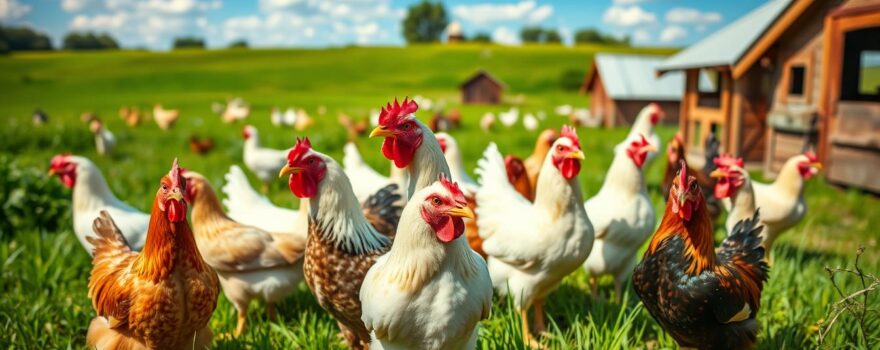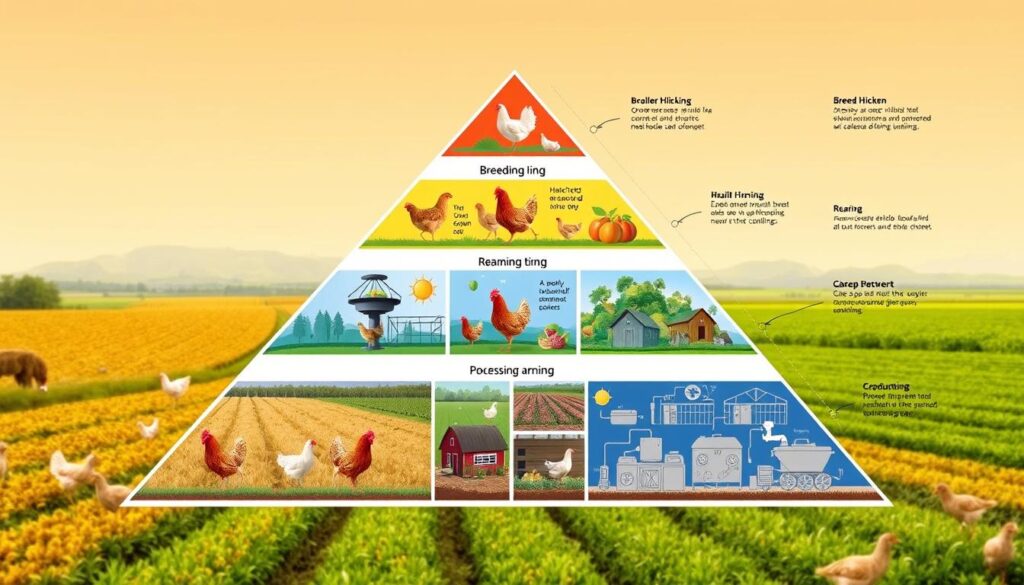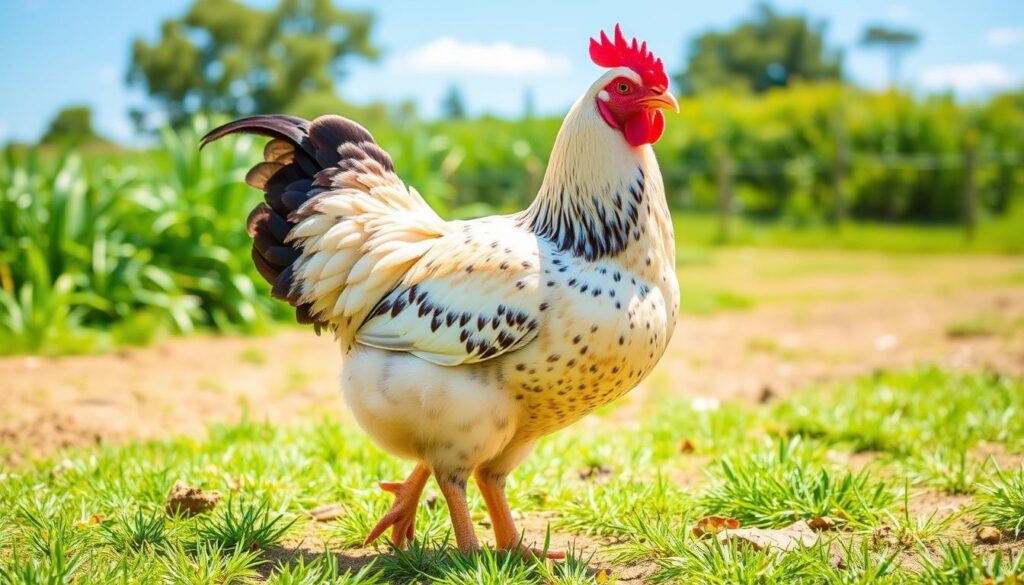
Many people start a backyard flock for fresh eggs. But, raising chickens for meat is also popular. When picking meat chickens, growth rate, mature weight, hardiness, and temperament matter. The commercial broiler chicken industry is big, with two main parts: raising birds for meat and breeding stock.
In 2005, the European Union produced 5.9 billion broiler chickens for meat. Just two or three companies supplied about 90% of the world’s breeder-broilers then.
The Major Breeds and their Contributions to the Broiler Chicken Industry, like Cobb, Ross, and Hubbard Broilers, are key. They’ve shaped Broiler Genetics and Poultry Breeding Programs. These efforts have boosted Meat Yield, Feed Conversion Efficiency, Growth Rate Improvement, Disease Resistance, and Heat Tolerance. These advancements have made the broiler chicken industry a global leader in poultry meat production.
Key Takeaways
- The commercial broiler chicken industry is highly industrialized, with a few breeding companies supplying most of the world’s breeder-broilers.
- Major broiler breeds like Cobb, Ross, and Hubbard have made significant contributions to improving meat yield, feed conversion efficiency, growth rate, disease resistance, and heat tolerance.
- Advances in broiler genetics and poultry breeding programs have enabled the rapid growth and global expansion of the broiler chicken industry.
- Backyard chicken enthusiasts can also raise meat-producing broiler breeds, considering factors like growth rate and mature weight.
- The broiler chicken industry’s success is a testament to the power of selective breeding and genetic improvement in livestock production.
Primary Breeders: Pioneers of Broiler Genetics
In the world of broiler chicken production, three companies lead the way. Cobb-Vantress, Aviagen, and Hubbard are at the forefront. They have shaped the industry with their innovative genetics and strategies.
These companies have made broiler chickens the top source of chicken meat in the U.S. Their work has been crucial to the industry’s growth.
Cobb-Vantress: Focusing on Feed Conversion
Cobb-Vantress is the largest broiler breeding company. They focus on improving feed conversion efficiency. This is key because feed is the biggest cost in producing Cobb Broilers.
By making Cobb Broilers better at turning feed into meat, Cobb-Vantress has helped make broiler production more affordable and profitable.
Aviagen: Global Leader with Diverse Brands
Aviagen is the world’s largest broiler breeding company, with a 44% global market share. They operate in over 85 countries. Their brands, Ross, Arbor Acres, and Lohmann Indian River (LIR), meet different market needs worldwide.
Aviagen’s focus on genetic improvement and sustainable practices has made them a global leader in the broiler industry.
Hubbard: Meeting Diverse Market Needs
Hubbard is part of Groupe Grimaud, the second-largest animal breeding company. They are in nearly 100 countries. Hubbard offers a variety of genetic products for different markets.
Hubbard’s diverse products and ability to meet various market demands have made them successful in the broiler chicken industry.
These primary breeding companies have transformed the broiler chicken industry. Their focus on genetic improvement, feed efficiency, and market-specific adaptations has made them key players.
Quantitative Genetics and Broiler Breeding Programs
The modern broiler chicken industry uses Broiler Breeding Programs and Quantitative Genetics to improve chicken genetics. These programs aim to pick breeding birds with traits that boost production. Traits like fast growth, better feed use, and high-quality breast meat are key.
New tech in computer science and DNA Chip Technology has helped a lot. Genomic Selection is a big help in picking the best birds. It uses DNA markers to find the best genes for traits. This leads to better chickens.
- Chicken broiler growth rate has increased by over 400% between 1950 and 2005.
- Feed provision is the poultry industry’s biggest environmental hotspot.
- Broiler breeding methods involve mass selection for traits like growth rate, breast meat yield, liveability, and feed use efficiency.
- Modern diets for broilers have a higher energy density and increased essential amino acids content compared to feeds from 30 years ago.
As more people want meat, the broiler industry must keep up. It will depend on good genetics, new tech, and smart breeding.
“Broiler breeding programs rely on quantitative genetics, computer science, and DNA chip technology to select breeding birds.”
The Broiler Production Pyramid
The genetic improvement of commercial broiler chickens is a result of a strategic production pyramid. At the top are the primary breeders. These include pedigree, Great Grandparent, and Grandparent generations. They are owned and managed by leading companies.
Eggs from pedigree flocks hatch into Great Grandparent flocks. Then, eggs from Great Grandparent flocks produce chicks for the Grandparent generation. This Grandparent stock is a mix of male and female lines, known as 2-way cross hybrids.
Day-old chicks from these lines are sent to hatcheries around the world. They become the Parent Breeder flocks. The last step is mating the male and female Parent Breeder lines. This creates the commercial 4-way cross broiler chickens that power the poultry industry.

“Genetic improvement accounts for approximately 80 to 90% of production improvements in the broiler industry.”
Major Breeds and their Contributions to the Broiler Chicken Industry
The world of poultry is made richer by many chicken breeds. The Cornish Cross, Jersey Giant, and Red Broiler are leaders in meat production.
The Cornish Cross is known for its fast growth and wide breasts. It’s bred for efficiency, growing quickly and developing lean muscle. This makes it a top choice for big farms. It can reach market weight in just 47 days, helping meet the demand for cheap, quality chicken.
The Jersey Giant is bigger and grows slower, which improves its flavor and versatility. It’s good for both meat and eggs, appealing to those who want a more traditional chicken experience.
The Red Broiler thrives in open spaces, offering meat that’s both tasty and textured. It’s great for farms that let chickens roam, meeting the need for chicken that’s raised right and is good for the planet.
Together, the Cornish Cross, Jersey Giant, and Red Broiler make the poultry industry diverse and strong. They offer different growth rates, meat types, and ways of farming. This meets the changing tastes of today’s chicken lovers.
“Broiler chickens accounted for an average of 67 percent of all poultry sector sales in the U.S. during 2013 – 2022.”
| Breed | Growth Rate | Meat Characteristics | Key Contribution |
|---|---|---|---|
| Cornish Cross | Rapid (47 days to market weight) | Broad breasts, lean muscle | Commercial efficiency, large-scale broiler production |
| Jersey Giant | Slower (69 days to market weight) | Robust size, fuller flavor | Dual-purpose breed, catering to traditional poultry consumers |
| Red Broiler | Moderate, adaptable to free-range | Textured, flavorful meat | Sustainable, ethically-sourced poultry options |
Broiler Breeder Management: Lighting and Mating
Effective broiler breeder management is key for better flock productivity. It ensures a steady supply of quality broiler chicks. Two important parts are photostimulation and natural mating.
Photostimulation for Controlled Sexual Maturity
Raising broiler breeders in controlled “pullet” houses helps manage their sexual maturity. These houses block out light, keeping it under 0.5 lux (0.05 foot-candles) when dark. This black-out pullet housing tricks the birds’ brains to wait for the right time to mature.
By adjusting lighting programs, managers can make the flock more uniform. They wait to introduce light until most pullets are ready, usually between 18 and 23 weeks.
Natural Mating and Flock Management Practices
Broiler breeders mate naturally, with a 10 males to 100 females ratio recommended. Starting with 8 males per 100 pullets can help reduce aggression and mortality. To keep mating rates up, spiking or adding new males is used.
“Careful broiler breeder management practices, including photostimulation and natural mating, are crucial for maintaining high flock productivity and consistent chick supply.”
By following these broiler breeder management principles, poultry farmers can improve their operations. This helps the broiler chicken industry thrive.
Cornish Cross: The Rapid Growth Superstar
The Cornish Cross is a top choice for meat chicken. It comes from mixing the White Cornish and White Plymouth Rock breeds in the 1950s. These chickens grow fast, reaching 4-5 lbs for hens and 6-7 lbs for roosters in 6 to 7 weeks.
Origins and Selective Breeding
The Cornish Cross was bred for fast growth and more meat. This careful breeding made it a top pick for meat production. It has changed the poultry industry worldwide.
Physical Traits and Behavior
A Cornish Cross chicken is known for its big body and white color. They can’t fly well and are mostly calm. They don’t lay many eggs, unlike other chicken breeds.
Role in Commercial Meat Production
The Cornish Cross has greatly changed the chicken meat industry. But, its fast growth and health problems have made some look at slower-growing breeds. Small farmers and homesteaders are interested in these heritage breeds.

“The Cornish Cross has become the standard for commercial meat production, but its rapid growth and health concerns have also inspired a growing interest in heritage breeds.”
Jersey Giant: The Massive Dual-Purpose Breed
The Jersey Giant is a famous meat chicken from the United States, especially New Jersey. It was developed in the late 19th to early 20th century. This chicken is known for being huge, with males up to 13 pounds and females around 10 pounds.
Origins and Size Development
The Jersey Giant was recognized by the American Poultry Association in 1922. It was made by mixing Black Java, Black Langshan, and Dark Brahma chickens. There might have been a bit of Mammoth and Jersey Blue in them too.
These chickens were bred for meat, to compete with turkeys. They were chosen for their big size and tender meat.
Male Jersey Giants can weigh 13-15 lbs., and females 10-11 lbs. The black ones are a bit heavier than the white ones. Males are 22-26 inches tall, and females 16-20 inches. It takes 8 to 9 months for them to grow big enough to eat.
Distinctive Appearance and Temperament
The Jersey Giant comes in Black, White, and Blue. They have a strong build, long back, and deep chest. They are friendly and can handle cold weather well.
They are good for homesteads because they are hardy and gentle. Some hens may go broody, while others won’t. They start laying eggs between 8 months and a year old, sometimes as early as 5 months. Their eggs are medium to large, brown, and might have speckles.
Even though roosters can be big on hens, they are not mean to people. They are great for backyards or small farms because they can handle cold and live a long time outside.
Red Broiler: Resilient Free-Range Foragers
The Red Broiler, also known as the Red Ranger or Freedom Ranger, is a breed known for its toughness and ability to adapt. They are loved for their tasty and tender meat. They can even keep laying eggs if they live longer than usual.
Origins and Adaptability
The Red Broiler comes from the French Broiler Industry. They are named for their reddish-brown feathers. These birds are bigger than many commercial chickens, with males weighing 6 to 7 pounds and females 5 to 6 pounds in 9 to 11 weeks.
Their slower growth rate makes their meat taste better and feel more tender. The Red Broiler is great at adapting and does well in free-range or pasture-raised systems. They are calm, easy to handle, and good at finding food on their own.
Physical Traits and Foraging Behavior
The Red Broiler has yellow legs, yellow skin, and dark brown or black feather tips. Their breast meat is long, firm, and tastes like dark meat, which many people enjoy.
These birds are natural foragers. They can find and eat many different insects, grasses, and other natural foods. This helps them stay healthy and makes their meat even better.
Welfare Considerations in Broiler Production
Modern broiler chickens grow very fast, leading to welfare concerns. They develop quickly, reaching slaughter weight sooner. This fast growth causes metabolic disorders like sudden death syndrome and ascites.
Breeding for bigger breasts has also harmed their walking. This puts extra stress on their hips and legs. Broilers often have skeletal problems, especially in their legs.
They are kept in crowded conditions, which can affect their health. But, better litter, temperature, and humidity are more important for their welfare than how crowded they are.
The broiler industry has improved a lot, but their welfare is still a big issue. More research and humane practices are needed. Programs like the Better Chicken Commitment can help improve their lives in the U.S.